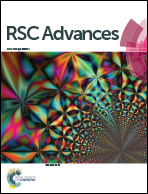The design and synthesis of porous NiCo2O4 ellipsoids supported by flexile carbon nanotubes with enhanced lithium-storage properties for lithium-ion batteries†
Abstract
Porous NiCo2O4 ellipsoids supported by flexile carbon nanotubes (denoted as NCO/CNTs) were successfully synthesized by a facile hydrothermal method followed by subsequent annealing in air. The structure and morphology of the materials were characterized by X-ray diffraction, field-emission scanning electron microscopy, and transmission electron microscopy. When evaluated as anode materials for lithium-ion batteries (LIBs), the NCO/CNTs composites exhibit a high and stable reversible capacity (1273.8 mA h g−1 at 500 mA g−1), excellent rate capability (593.0 mA h g−1 at 4000 mA g−1), and long cycling stability (no capacity fade over 200 cycles). The improved performance of these LIBs can be attributed to the unique 3D porous NCO/CNTs composite frameworks, which will enhance electrical conductivity of the materials, facilitate fast ion/electron transport through the electrode, and accommodate massive volume expansion/contraction during cycling. Furthermore, the synthetic strategy is simple but very effective, it can be easily extended to prepare many other metal oxides with the CNTs acting as the conductive network and used as promising anode materials for high-performance LIBs.


 Please wait while we load your content...
Please wait while we load your content...